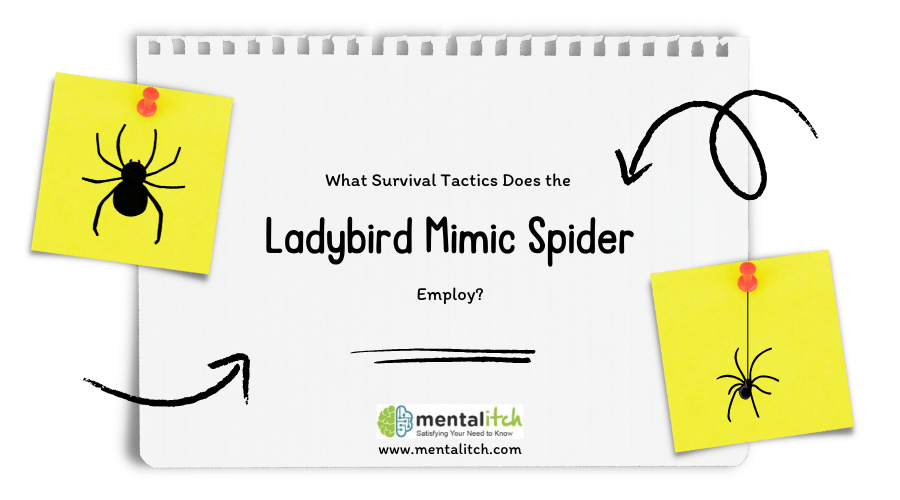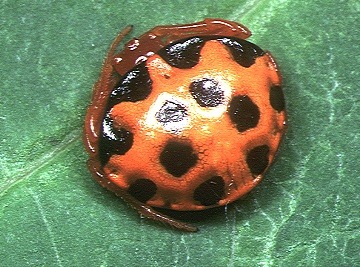Imagine you’re walking through a lush garden, and you spot a ladybird. But on closer inspection, you realize it’s not what it seems—it’s a Ladybird Mimic Spider, a master of deception. This spider employs a fascinating survival tactic by masquerading as a harmless ladybird, not just to blend in but to ward off predators who steer clear of the toxic beetles it imitates. But how does this mimicry work in detail, and what other strategies do these spiders use to survive and thrive in their habitats?
Let’s uncover the layers of their survival tactics, which go far beyond their clever disguise.
Mimicking Ladybirds
One might never guess that the seemingly harmless Ladybird Mimic Spiders, with their vibrant hues and spotted patterns, are actually cunning predators in disguise. These spiders have mastered the art of mimicry, sporting bright red or orange bodies adorned with black spots, mirroring the appearance of ladybirds to perfection. This clever camouflage isn’t just for show; it plays a pivotal role in their survival strategy.
By mimicking ladybirds, these spiders blend seamlessly into their surroundings, making them nearly invisible to both predators and prey. Their round body shape further aids in this deception, allowing them to hide in plain sight among real ladybirds. This disguise serves a dual purpose: it not only keeps them safe from potential threats but also positions them as unsuspecting predators. Unsuspecting insects, fooled by the spider’s harmless exterior, venture too close, only to be ambushed with surprising speed.
The venom these spiders inject immobilizes their prey, ensuring a successful hunt. Each species of Ladybird Mimic Spider has honed this mimicry to a fine art, displaying unique adaptations that enhance their ability to survive and thrive in their chosen habitats. Through this ingenious use of camouflage, they reveal the complexity and cunning nature of their predatory tactics.
Coloration Strategy
Having explored how Ladybird Mimic Spiders use their appearance to deceive, let’s now focus on their coloration strategy and its role in their survival. The ingenious use of bright red or orange hues with black spots is not just a random choice. It’s a meticulously evolved tactic that serves multiple purposes in the harsh realities of the wild. This coloration strategy is a cornerstone of their survival, enabling them to blend seamlessly into their environments and the community of ladybirds they mimic.
- Bright Red or Orange with Black Spots: This specific color pattern is a dead ringer for ladybirds, facilitating an exceptional level of camouflage. It’s this mimicry that throws off both prey and predators.
- Aposematic Mimicry: The vivid colors serve as a warning signal, suggesting toxicity or danger to potential threats. This is a clever ruse since the spider itself may not be harmful.
- Enhanced Survival: By adopting this coloration strategy, the Ladybird Mimic Spider significantly boosts its chances of avoiding predation and successfully catching prey.
Through these strategies, the spider not only deceives its immediate threats but also secures its place in the ecosystem. The coloration strategy is a testimony to the complex and adaptive nature of mimicry and camouflage in the animal kingdom.
Behavioral Deception
Beyond their striking coloration, Ladybird Mimic Spiders also engage in behavioral deception, skillfully imitating the movements and habits of real ladybirds to trick both their prey and predators. This mimicry isn’t just about looking the part; it’s a dynamic performance that turns these spiders into masters of disguise in their ecosystem. By adopting the leisurely pace and harmless demeanor of ladybirds, they effectively lure in unsuspecting insects. It’s a clever ruse that plays on the expectations of other creatures, making the spiders appear benign rather than predatory.
The bright coloration of these spiders, mirroring the red or orange bodies with black spots typical of ladybirds, is a visual trick that complements their behavioral mimicry. This combination of survival tactics renders them almost invisible to the threats and opportunities surrounding them. Predators often overlook them, mistaking them for the toxic ladybirds they resemble, while prey wanders too close, deceived by the guise of harmlessness.
This deceptive behavior is a key strategy in the Ladybird Mimic Spider’s survival playbook. It’s a fascinating example of how nature evolves intricate solutions for survival, turning these spiders into efficient predators cloaked in the guise of one of nature’s most familiar and beloved insects.
Venomous Defense
In addition to their deceptive behaviors, Ladybird Mimic Spiders also utilize venom to swiftly immobilize their prey. This venomous defense isn’t just a critical aspect of their survival toolkit; it’s a proof of the evolutionary innovations that allow them to thrive in their ecological niches. By injecting toxins, these spiders effectively subdue their targets, making it easier to feast without a fight. It’s a clever strategy that guarantees they don’t expend unnecessary energy during predation.
Consider the following points to better understand how their venomous defense works:
- Efficient Predation: The venom contains potent toxins that quickly incapacitate insects, allowing the spider to conserve energy for other survival activities.
- Overcoming Challenges: Even larger or more agile prey aren’t safe. The spider’s ability to immobilize them levels the playing field, ensuring that size or speed doesn’t dictate the outcome of their hunting efforts.
- Survival Mechanism: By employing venomous defense, Ladybird Mimic Spiders secure a steady food supply, which is essential for their survival in the wild.
The venomous defense of Ladybird Mimic Spiders is a proof of the evolutionary innovations that allow them to thrive in their ecological niches. It’s not just about predation; it’s about survival.
Hunting Techniques
Ladybird Mimic Spiders employ a cunning approach to hunting, patiently waiting to ambush their prey with remarkable agility and deceptive mimicry. They’ve mastered the art of blending in, using their appearance to their advantage. You’ll be amazed to know these spiders don’t rely on webs to catch their meals. Instead, they’re all about the element of surprise. They’re not just about insects; they’ve got a sweet tooth for nectar, balancing their diet for better security and reproduction.
Their strategy is simple yet effective. By mimicking ladybirds, not only do they avoid suspicion, but they also get close enough to their prey without alarming them. This tactic, combined with their patience, allows them to launch a swift attack when the moment is just right.
Here’s a quick glance at their hunting technique:
| Strategy | Description | Benefit |
|---|---|---|
| Mimicry | Imitating ladybirds in appearance and movement | Avoids detection |
| Patient hunting | Waiting on leaves, flowers, or bark | Ensures surprise attack |
| Nectar consumption | Balances diet with nectar along with insects | Supports security and reproduction |
This unique blend of mimicry, patience, and agility makes them formidable hunters, ensuring their success in the wild.
Avoiding Predators
While mastering hunting techniques secures their success in capturing prey, Ladybird Mimic Spiders also excel at avoiding predators through their remarkable mimicry. By imitating the appearance of ladybirds, they tap into a survival strategy that reduces their chances of being targeted. Ladybirds are known for their toxic nature, making them unappealing to many predators. This clever act of mimicry provides the Ladybird Mimic Spider with a notable survival advantage, allowing them to blend seamlessly into their environment without drawing unwanted attention.
To paint a clearer picture, consider the following:
- The spider’s mimicry involves copying the bright colors and patterns of ladybirds, which signal toxicity to potential predators.
- This deceptive appearance deters predators, who remember the unpleasant experience associated with ladybirds’ toxic nature.
- The ability to avoid predation through mimicry notably increases the spider’s chances of survival, enabling them to live longer and reproduce.
Reproductive Tactics
Akio Tanikawa, Paraplectana.tsushimensis.female.-.tanikawa, CC BY-SA 2.5
To confirm their lineage survives, female ladybird mimic spiders meticulously lay their eggs in secure silk sacs for incubation and protection. These silk sacs aren’t just about keeping the eggs inside safe; they’re a mother’s fortress, guarded tirelessly until the spiderlings hatch. This unwavering vigilance guarantees the survival of the next generation, showcasing the lengths these mothers will go to for their offspring.
But before the eggs are even laid, there’s the matter of mating, which in the world of the ladybird mimic spider, is anything but straightforward. Male ladybird mimic spiders commence on an intricate courtship, a dance of specific movements and vibrations designed to woo. This isn’t just about showing off; it’s a critical test. The female evaluates these performances, choosing her mate based on the quality of his courtship. It’s a rigorous selection process that underscores the importance of these rituals in ensuring the survival and reproductive success of the species.
Through this combination of careful egg protection and selective mating processes, the reproductive tactics of the female ladybird mimicspider play a pivotal role in the species’ continuation. Their survival hinges on these meticulous strategies, demonstrating nature’s complex interplay of survival and reproduction.
Habitat Adaptation
Adapting to a range of environments, from lush forests to bustling urban areas, these spiders excel in finding the perfect hideout. Their ability to adapt to various habitats showcases their resilience and versatility. Thanks to their compact size, ranging from millimeters to one centimeter, they can easily move through and hide among plants and debris, waiting silently for their next meal. The round body shape and bright red or orange color, adorned with black spots, not only serve as a warning to potential predators but also allow them to blend seamlessly among flowering plants and other insects.
To paint a picture for the audience, consider these environments where Ladybird Mimic Spiders thrive:
- Lush forests: Offering a plethora of hiding spots and an abundance of prey, these areas are ideal for their survival.
- Meadows and gardens: Flowering plants in these areas provide excellent camouflage for the spiders’ bright bodies with black spots.
- Urban areas: Even in less natural settings, they find nooks and crannies to adapt and continue their hunting, showing their incredible adaptability.
Their survival and hunting efficiency in diverse environments are evidence of the adaptability of Ladybird Mimic Spiders.
Lifespan and Survival
Having explored how Ladybird Mimic Spiders thrive in various habitats, let’s now focus on their lifespan and the survival strategies that enable them to evade predators and secure prey. You’ll find that these remarkable creatures live for about one to two years, a duration which can vary depending on their species and the environment they’re in.
Throughout their lives, they undergo several molting stages. This isn’t just about growing bigger; it’s about adapting. As they shed their exoskeleton, they’re basically preparing their bodies to better suit their needs, be it for movement or for making themselves less visible to threats.
Size plays a critical role in their survival. Being no larger than one centimeter, they can easily blend into their surroundings, mimicking the red and black colors of ladybirds. This camouflage isn’t just for show; it’s a vital survival tactic that helps them stay off the radar of predators while they sneak up on their prey.
Ladybird Mimic Spiders are solitary creatures. They establish and defend territories, ensuring that they have ample space to hunt without competition. This territorial behavior is key to their survival, allowing them to thrive as efficient predators, utilizing both mimicry and camouflage to adapt and survive in their chosen habitats.
Conclusion
To sum up, you’ve learned how the Ladybird Mimic Spider masters survival through impressive tactics. By mimicking ladybirds, they blend in perfectly, using their coloration and behavior to deceive both prey and predators. Their venomous bite allows for effective hunting without webs, and they cleverly avoid predators with their deceptive appearance. They’re adaptable, thriving in various habitats, and guarantee their survival and reproduction through strategic hunting and dietary choices. With these skills, they’re truly exceptional in the animal kingdom.

